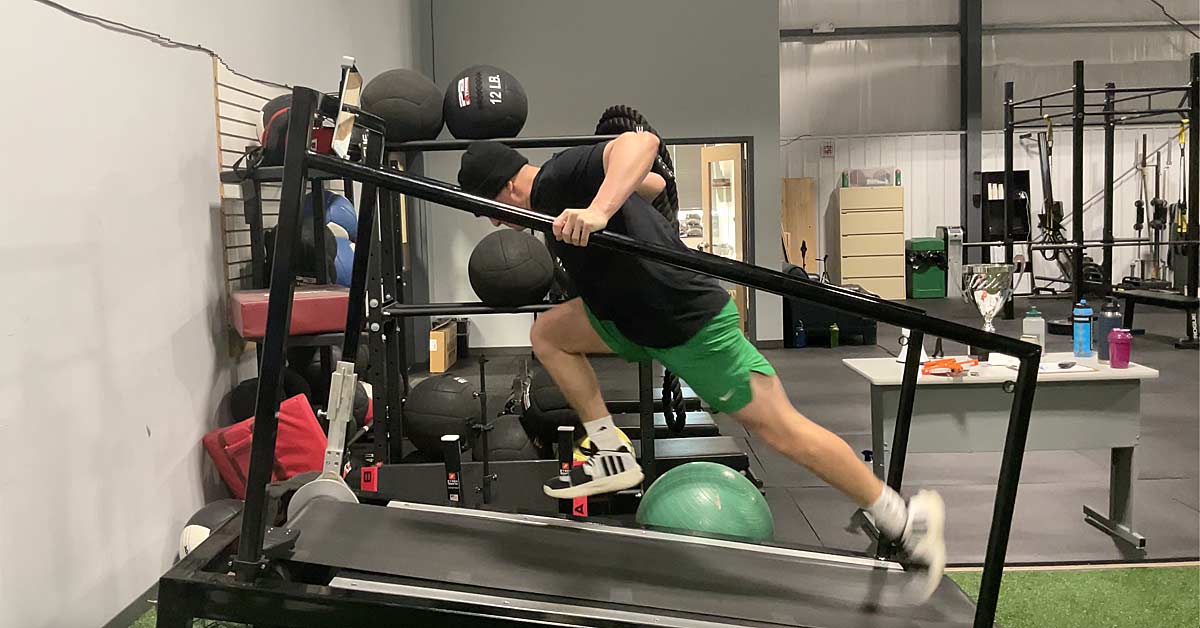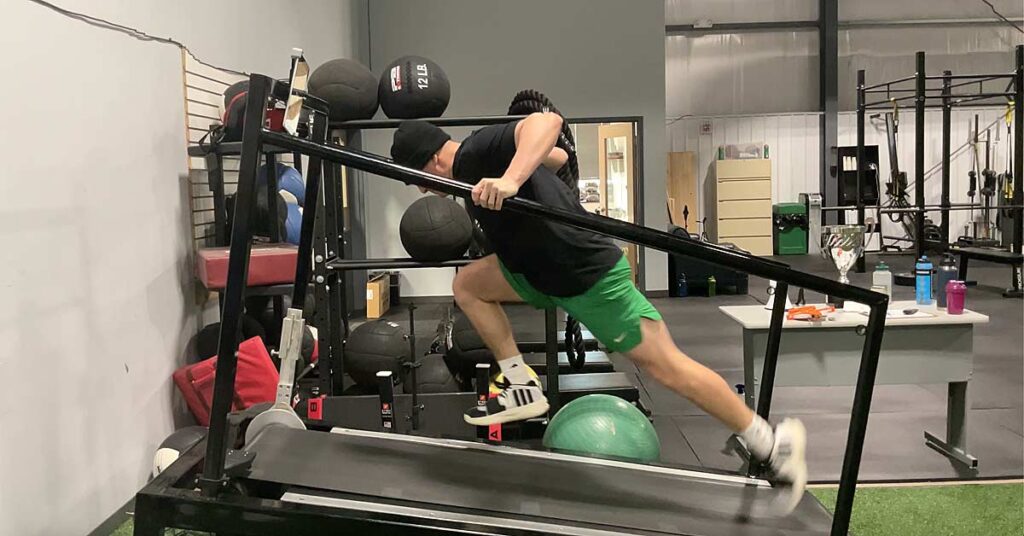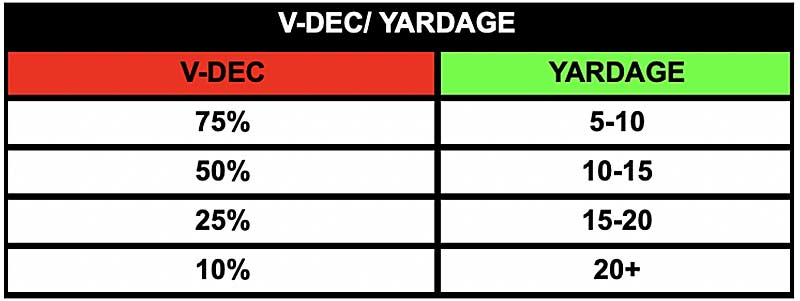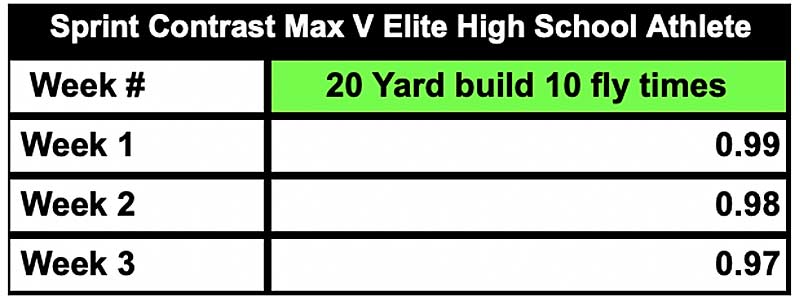

Most of us have heard of the French Distinction technique, popularized by Cal Dietz. For these unfamiliar, the strategy consists of a heavy compound motion, an unweighted plyometric, a weighted plyometric, and an assisted plyometric, utilizing post-activation potentiation (or PAP) to extend energy and pace.
The French Distinction technique creates an surroundings for repeated energy outputs, which is nice in relation to repeat dash potential for staff sport athletes. Vitality system improvement is crucial for all athletes, and all vitality methods are current always. Group sports activities are sometimes received on massive highly effective performs (breakaways from defenders, closing distances, and fast bursts of acceleration/deceleration).
We wish to practice the ATP-CP system—our “quick twitch,” in layman’s phrases. It is very important bear in mind we’re coaching max effort outputs, so enough relaxation between reps is crucial. Right here at Complete Athlete Efficiency (TAP), we use the mannequin of 1 minute of relaxation for each 10 yards sprinted. The choices are seemingly countless for no matter actions you choose.
Sprint Contrast, modeled in the same format as French Contrast, is a method we love for repeat sprint ability and speed development. Click To Tweet
These “seemingly countless” alternatives have led us to assume exterior the field in relation to dash coaching. Dash Distinction, modeled in the identical format as French Distinction, is a technique we love for repeat dash potential and pace improvement. We’ve applied this as a heavy resisted dash, vector-specific unweighted plyometrics, resisted dash, and acceleration or fly. (This mannequin is, after all, topic to alter.)
As coaches, we must always perceive when to implement a technique like this, bearing in mind the extent of the athlete, time of yr, and present situation of the athlete(s) you’re employed with. This isn’t simply one thing to throw your athletes into—there must be a interval of build-up on technical qualities together with physiological qualities. We like utilizing this technique in preparation for peaking our athletes as a result of it lays a strong basis for enhancing qualities of energy and repeat dash potential.
How It Works
The best way we went about utilizing this technique was easy. If we have a look at a five-day coaching plan (Monday–Friday), Monday is acceleration-based, Wednesday is max velocity focus, and Friday is a change of path and agility-focused day. We used this technique on Monday and Wednesday, which had been our linear sprint-focused days.
When programming pace, we use load-velocity profiling (LVP), which permits us to pick a load that may deliver that athlete’s sprinting velocity all the way down to a sure velocity. For instance, if an athlete who runs a 1.02 10-yard fly (20 mph) does a dash with a sled—and that sled reduces his pace to 10 mph—we now know that the load on that sled reduces the athlete’s velocity by 50% (10 mph).
Relying on the standard we need to practice, we are going to use a velocity decrement that correlates to that high quality. For instance, with an athlete who struggles in early acceleration, we might select a heavier V-DEC (velocity decrement), from 50% to 75%. We use these loading parameters to assault sure sprinting qualities:
- 75%+ beginning power
- 40%–60% energy
- 10%–40% pace power (late acceleration)
- 10% technical competency
When implementing these heavier hundreds for resisted sprinting, you will need to take yardage into consideration. It’s unrealistic to anticipate somebody to dash with a 75% velocity decrement previous 10 yards.
When implementing these heavier loads for resisted sprinting, you must take yardage into consideration. It’s unrealistic to expect someone to sprint with a 75% velocity decrement past 10 yards. Click To Tweet

With our loading and high quality parameters lined, let’s dive into the strategy and train choice we used.
The SHREDmill—a self-propelled, non-curved, non-motorized treadmill—is an efficient device for working early acceleration, from each a stimulus and a technical perspective. The SHREDmill is especially nice from a switching side.
Video 1. A key efficiency indicator for us is the flexibility to change from the hip, which may be developed in coaching with a SHREDmill.
On our acceleration day, our first train was a SHREDmill Gear 1 dash. The belt offers prompt suggestions on the athlete’s potential to change from the hip. Gear 1 on the SHREDmill is heavy, sometimes a 40%–60% V-DEC, relying on how technically sound the athlete is. Should you do not need a SHREDmill, it’s okay! You may as well use a heavy sled.
Video 2. We sometimes cue “open up” (massive thigh splits), “assault again,” and “away.”
The second motion we selected was a horizontal hurdle hop right into a broad leap. This plyometric permits us to maintain consistency with our path of pressure within the horizontal vector. Any type of horizontal plyometric is okay.
Video 3. Area out hurdles slightly additional than your typical hurdle hop. We are not looking for an prolonged floor contact into the broad leap.
Our third motion (weighted plyometric) was a 30% V-DEC dash on the Run Rocket (or sled) for 10 yards. Once more, right here we simply need to improve the neural drive proper earlier than the publicity of the 5/10 or 10/20 acceleration.
Video 4. We sometimes cue our athletes on acceleration days to be “violent at the beginning.”
Lastly, the athlete would run the 5/10 or 10/20 acceleration. Now we have seen plenty of athletes set private data due to the massive potentiation impact. Coaches have to remember to preserve the yardage and quantity low in resisted sprints and plyometrics to not overcook the steak earlier than the lasered dash time.
Video 5. Utilizing laser timers offers us prompt suggestions on every dash whereas additionally upping athlete intent.
We used this idea on our max velocity day as nicely. Our thought course of on making use of this idea was barely completely different. We perceive that max velocity sprinting is the quickest plyometric that we are able to do. Preserving that in thoughts, our potentiation concepts had been barely completely different.
There’s a advantageous line between cooking the steak and potentiating an athlete. Max velocity sprinting may be very neurologically demanding, so we don’t need to lavatory the system down with heavy resisted sprints earlier than an extended dash at high pace. As an alternative, we used an overspeed motion.
Max velocity sprinting is very neurologically demanding, so we don’t want to bog the system down with heavy resisted sprints before a longer sprint at top speed. We use an overspeed movement instead. Click To Tweet
Overspeed actions pressure athletes to change and trade their limbs sooner than they might manually. Our athletes appear to really feel “supercharged,” as if it has some type of neurological potentiation impact. Our overarching theme of constructing repeat dash potential remains to be intact, with the athlete nonetheless being tasked with delivering excessive energy outputs at an excellent larger velocity. This differs from our acceleration days, that are full of brief bursts of heavier hundreds at decrease velocities and are extra “energy” primarily based.
Our first motion on at the present time was a 15-yard Run Rocket dash at a 25% V-DEC, making an attempt once more to boost the neural drive and potentiate the athlete.
Video 6. We wish to cue “assault the primary 10 yards,” then begin to transition.
Subsequent was a excessive double hurdle hop. Staying with our theme of a vector-specific plyometric, we wished a plyometric with a extra vertical orientation of pressure.
Video 7. We encourage our athletes to spend little time on the bottom.
The third motion we chosen was an assisted primetime. Primarily, we would like the athlete to really feel what it’s like to change quick from the hip, just like our intention with the SHREDmill. The flexibility to change and trade our limbs is a KPI (key efficiency indicator) in each acceleration and max velocity sprinting.
The overspeed stimulus is a good potentiator earlier than operating at max velocity. Observe that we solely do that with higher-level athletes who can deal with the stimulus. For our youthful athletes, we used a trampoline RFI (reflexive firing isometric) dash. The trampoline gives an analogous stimulus within the method that the athlete has to change sooner due to the reflexive nature of the trampoline. It additionally permits us to give attention to positioning, timing, and rhythm.
Video 8. This can be a motion that we solely use with our extra superior athletes.
Video 9. Positioning cues we use for this motion are: “be tall,” “raise front-side” (A-position), and “change onerous and quick.”
Lastly, the athlete would run the 20-yard construct 10-fly. Identical to on our acceleration days, we noticed plenty of our athletes set private bests.
Video 10. We wish to remind our athletes to chill out and really feel clean, to not battle for a private greatest.
Outcomes on RSA
When serious about staff sports activities and the calls for on athletes, repeat dash potential is paramount. The flexibility to repeat and produce energy time and again is crucial, making this technique optimum for staff sport athletes.

As you possibly can inform, this specific athlete set private bests on his 20-yard construct 10 fly three weeks in a row. He elevated his high pace window (pace reserve has grown), whereas additionally growing his potential to repeat brief bursts of acceleration.
Observe that that is only a technique, not a coaching precept. Persist with what is smart in your athletes. However we’ve used the strategy right here at TAP and seen good outcomes with it.
Because you’re right here…
…now we have a small favor to ask. Extra individuals are studying SimpliFaster than ever, and every week we deliver you compelling content material from coaches, sport scientists, and physiotherapists who’re dedicated to constructing higher athletes. Please take a second to share the articles on social media, interact the authors with questions and feedback under, and hyperlink to articles when applicable you probably have a weblog or take part on boards of associated matters. — SF
